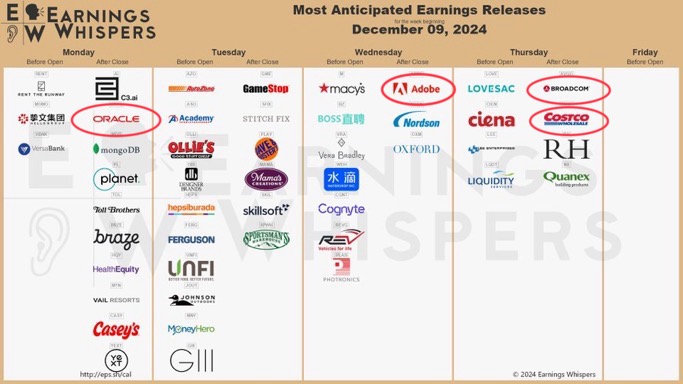先週の米国相場は、長期金利とVIXが下落し、株価指数ではナスダックを中心としたハイテク銘柄に強い動きが見られました。一方で、相場全体としては短期的に下落トレンド入りしている銘柄が増えてきており、やや注意が必要な状況です。
今週はORCL、ADBE、ORCL、COSTの決算と、12/11のCPI発表後の相場の反応に注目したいと思います。
それでは、チャートを確認しながら先週の相場を振り返っていきましょう。
先週の振り返り
相場環境
米国債10年物は-0.60%の下落でした。3週間連続で下落しており、短期的な下落トレンドとなっています。株式指数にはポジティブな状態です。

VIXは-5.48%の下落でした。VIXも3週間連続の下落となっています。過去2年間を見ると、12付近で下げ止まることが多かったです。VIXが下げ止まって反発する動きが出てこないかを注意深く観察するのが良さそうです。

上昇トレンドの銘柄数の割合は、買われ過ぎの水準から大きく下落し、短期的な下落トレンドに入りました。ナスダック、S&P500の指数は上昇を続けていますが、相場全体を見渡すと短期的な下落トレンドに転換した銘柄が増えてきていることを示しています。

ナスダックの分析
ナスダックの月足チャートです。12月の第1週が終わり、現時点の騰落率は+3.28%の上昇となっています。先月に続き強いスタートを切っています。

ナスダックの週足チャートです。先週は+3.28%の上昇で11月の高値を超えて新高値を更新しています。

ナスダックの高値-安値銘柄数はプラス圏内で推移しているものの短期で見ると下落傾向となっています。上昇に転換するまではやや注意して推移を見る必要があります。ナスダックの指数が上昇している状態でこのチャートが下落している時は、大型ハイテク株以外が相対的に弱い傾向にあることを示しています。

ダウの分析
ダウの月足チャートです。12月の現時点の当落率は-0.64%となっています。先月の非常に強い上昇から調整する動きとなっています。11月の強い上昇で移動平均線からの乖離が急に大きくなってきています。

ダウの週足チャートです。先週は-0.64%の下落でした。44500付近の抵抗線まで戻ってきています。この付近で揉み合いになる可能性がありそうです。

S&P500の分析
S&P500の月足チャートです。12月の現時点の騰落率は+0.95%となっています。高値の更新が続いています。

S&P500の週足チャートです。先週は+0.95%の上昇でした。3週間連続で安定した上昇を続けています。

ラッセル2000の分析
ラッセル2000の月足チャートです。現時点の12月の騰落率は-1.29%です。ダウと同様に先月の非常に強い上昇から調整に入る動きが見られます。

ラッセル2000の週足チャートです。先週は-1.29%の下落でした。前週の上昇分を打ち消す下落となっており、短期的にはやや弱気なチャートです。

コモディティ先物の分析
原油は-1.49%の下落でした。2週連続で下落しており、過去に何度も反発してきた66付近の抵抗線に近づいています。この水準を維持できるかどうかがポイントになりそうです。

天然ガスは-8.53%の下落でした。上昇トレンドライン付近まで戻ってきています。 10月から開始した上昇トレンドはかろうじて維持していますが、短期的には下目線で推移しそうなチャートです。

金は-0.80%の下落でした。2週連続で下ヒゲをつけながら下落しています。長期金利が下落しているときは金は上昇することが多いのですが、直近の2週間は金利と共に金も下落しています。20EMAに近づいたところで買われて反発する動きが見られます。

銅は+1.36%の上昇でした。3週連続で上昇しています。9月後半から始まった下落トレンドはまだブレイクできていません。下落トレンドラインに触れたところで売られて上ヒゲをつけており、まだ売り手が優勢に見えます。

セクター分析
先週はセクターによる明暗がくっきりと分かれ、一般消費財、通信サービス、情報技術が上昇して、その他のセクターは下落しています。特にエネルギーと公益事業が弱いです。過去1ヶ月では、一般消費財が強く、素材、エネルギー、ヘルスケアに弱い動きが見られます。

業種別の週間パフォーマンスを見ると、先週は自動車、インターネット小売、インターネット、ゲーム、コンピューターハード、ソフトウェア、半導体が強く、健康保険、石炭、石油が弱いです。


個別銘柄の動向
先週は左上(ハイテク関連)が上昇し、右下(エネルギー、工業関連)が下落する展開となっています。大きく上昇したのは、AMZN、TSLA、META、TSM、AVGO、CRMなどの時価総額の大きなハイテク銘柄でした。一方で大きな下落が見られるのは、UNH、ELVなどの健康保険、CVX、COPなどの石油・ガス関連銘柄、DHI、LENなどの住宅建築銘柄、UPS、FDXなどの物流銘柄です。

今週の戦略
先週はハイテク銘柄には強い動きが見られ、好決算を発表した銘柄には力強い買いが入って上昇している一方で、相場全体としては買われ過ぎの水準から下落している銘柄が多くなってきており、やや注意が必要な相場環境です。
今週も先週と同様に大きく上昇した銘柄のポジションを削減を進めて手元資金を増やし、次の調整後の上昇の波に備えたいと思います。
監視銘柄
先週の決算発表後に強い上昇が見られたASAN、CRDO、LULUを監視銘柄に加えています。

監視銘柄のチャートはこちら。
今週の決算発表予定
今週はORCL、ADBE、ORCL、COSTの決算に注目です。

12/9
AI BRZE CASY HQY MDB MTN ORCL TOL
12/10
ASO AZO FERG OLLI
GME
12/11
M
ADBE NDSN
12/12
CIEN
AVGO COST RH


